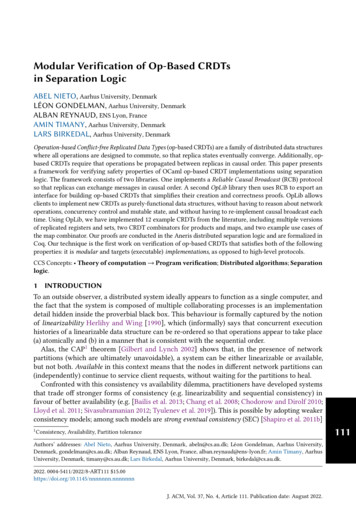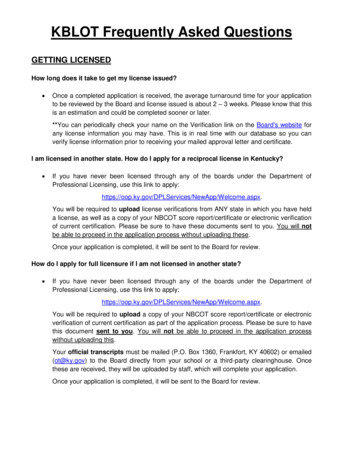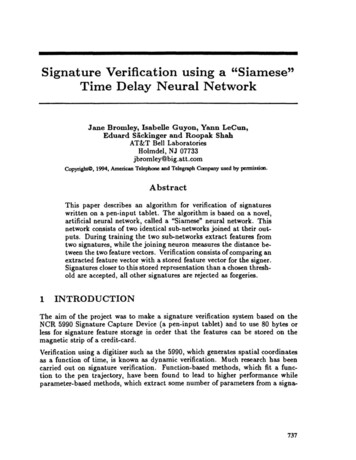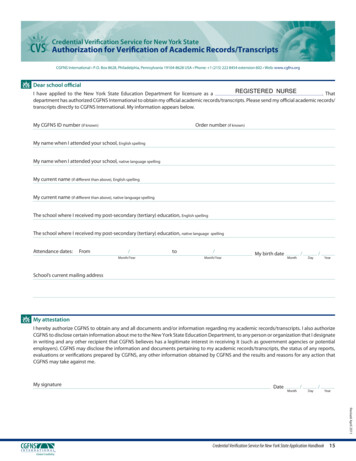
Transcription
Modular Verification of Op-Based CRDTsin Separation LogicABEL NIETO, Aarhus University, DenmarkLÉON GONDELMAN, Aarhus University, DenmarkALBAN REYNAUD, ENS Lyon, FranceAMIN TIMANY, Aarhus University, DenmarkLARS BIRKEDAL, Aarhus University, DenmarkOperation-based Conflict-free Replicated Data Types (op-based CRDTs) are a family of distributed data structureswhere all operations are designed to commute, so that replica states eventually converge. Additionally, opbased CRDTs require that operations be propagated between replicas in causal order. This paper presentsa framework for verifying safety properties of OCaml op-based CRDT implementations using separationlogic. The framework consists of two libraries. One implements a Reliable Causal Broadcast (RCB) protocolso that replicas can exchange messages in causal order. A second OpLib library then uses RCB to export aninterface for building op-based CRDTs that simplifies their creation and correctness proofs. OpLib allowsclients to implement new CRDTs as purely-functional data structures, without having to reason about networkoperations, concurrency control and mutable state, and without having to re-implement causal broadcast eachtime. Using OpLib, we have implemented 12 example CRDTs from the literature, including multiple versionsof replicated registers and sets, two CRDT combinators for products and maps, and two example use cases ofthe map combinator. Our proofs are conducted in the Aneris distributed separation logic and are formalized inCoq. Our technique is the first work on verification of op-based CRDTs that satisfies both of the followingproperties: it is modular and targets (executable) implementations, as opposed to high-level protocols.CCS Concepts: Theory of computation Program verification; Distributed algorithms; Separationlogic.1INTRODUCTIONTo an outside observer, a distributed system ideally appears to function as a single computer, andthe fact that the system is composed of multiple collaborating processes is an implementationdetail hidden inside the proverbial black box. This behaviour is formally captured by the notionof linearizability Herlihy and Wing [1990], which (informally) says that concurrent executionhistories of a linearizable data structure can be re-ordered so that operations appear to take place(a) atomically and (b) in a manner that is consistent with the sequential order.Alas, the CAP1 theorem [Gilbert and Lynch 2002] shows that, in the presence of networkpartitions (which are ultimately unavoidable), a system can be either linearizable or available,but not both. Available in this context means that the nodes in different network partitions can(independently) continue to service client requests, without waiting for the partitions to heal.Confronted with this consistency vs availability dilemma, practitioners have developed systemsthat trade off stronger forms of consistency (e.g. linearizability and sequential consistency) infavour of better availability (e.g. [Bailis et al. 2013; Chang et al. 2008; Chodorow and Dirolf 2010;Lloyd et al. 2011; Sivasubramanian 2012; Tyulenev et al. 2019]). This is possible by adopting weakerconsistency models; among such models are strong eventual consistency (SEC) [Shapiro et al. 2011b]1 Consistency,111Availability, Partition toleranceAuthors’ addresses: Abel Nieto, Aarhus University, Denmark, abeln@cs.au.dk; Léon Gondelman, Aarhus University,Denmark, gondelman@cs.au.dk; Alban Reynaud, ENS Lyon, France, alban.reynaud@ens-lyon.fr; Amin Timany, AarhusUniversity, Denmark, timany@cs.au.dk; Lars Birkedal, Aarhus University, Denmark, birkedal@cs.au.dk.2022. 0004-5411/2022/8-ART111 15.00https://doi.org/10.1145/nnnnnnn.nnnnnnnJ. ACM, Vol. 37, No. 4, Article 111. Publication date: August 2022.
111:2Nieto et al.and causal consistency [Ahamad et al. 1995]. For example, in SEC two processes that read from areplicated register might observe different values even though no intervening writes have occurred(something not possible when reading from sequentially-consistent local memory from within aprocess). Eventually, however, the state of the replicated register at different replicas must converge.More precisely, SEC requires the following two properties (note the first is a liveness propertywhile the latter is a safety property): (Eventual Delivery) An update delivered to a correct replica is eventually delivered to all replicas. (Convergence) Replicas that have delivered the same updates eventually reach equivalent states.Conflict-free Replicated Datatypes (CRDTs) [Shapiro et al. 2011a] are a class of distributed systemswhere a data structure (e.g. register, set, or map) is replicated over multiple replicas that mutate itsstate via local operations. Because replicas are allowed to invoke operations without coordinatingwith others, different replicas might arrive at conflicting states. CRDTs resolve such conflictsautomatically. There are two main ways of going about this. One option is to model the replicastate as a (join) semilattice, so that merges are accomplished by taking least upper bounds (joins);these are state-based or convergent CRDTs. Changes are then propagated by sending the entirestate to other replicas on the (possibly unreliable) network. Another option is to propagate, insteadof the entire state, just the effect of each individual update. It becomes then necessary to enforcethat each operation is executed exactly once (at most once for the convergence and at least one forthe eventual delivery properties above), which typically requires broadcasting primitives that offerreliable delivery. Furthermore, it is also necessary to enforce that some or all operations commuteso that concurrent operations can be applied in any order. This last class, known as operation-based(op-based) or commutative CRDTs, is the focus of this paper2 .Consider the following example of a counter data structure replicated over two nodes 𝐴 and 𝐵:(* Node A *)add 1; add 200(* Node B *)add 2; let v read () in assert((v 2) (v 3) (v 203))The counter exports two operations: add(z), which adds an integer z to the counter, and read(),which returns the counter’s current value. This CRDT is known as a positive-negative counter(PN-Counter)[Shapiro et al. 2011a].One question of interest for the example above is what are the possible values of v. Becausethe counter should remain available even if 𝐴 and 𝐵 are partitioned, 𝐴’s add(1) should executewithout trying to synchronize with 𝐵. This means that 𝐴’s and 𝐵’s add operations potentially happenconcurrently. By contrast, when 𝐴’s two operations are broadcast to 𝐵, they should be applied by 𝐵following 𝐴’s program order. Finally, when 𝐵 reads, we do not know whether 𝐴’s updates havebeen received, but we do expect that the add(2) has been recorded locally. This means that thepossible values for v are 2 (only the local add has been applied), 3 (only the 𝐴’s first add has beenapplied), and 203 (all add have been applied). Results like 0, 200 and 202 are not valid answers.Causal Delivery. Our intuitions about valid execution traces in the example above can be capturedby a happens-before or causality relation on events [Lamport 1978]. Let 𝑎 and 𝑏 be two events(possibly taking place at different processes). Then 𝑎 happens before 𝑏 (and 𝑏 is causally dependenton 𝑎), written 𝑎 𝑏, if one of the following holds: 𝑎 and 𝑏 take place in the same process, and 𝑎 𝑏 according to program order. 𝑎 is the event of sending a message 𝑚 and 𝑏 is the corresponding event where 𝑚 is received. 𝑎 𝑐 and 𝑐 𝑏 for some other event 𝑐 (the transitive closure of the above two rules).2 From now on whenever we use the term CRDTthe reader can safely assume that we mean op-based CRDT, unless explicitlynoted otherwise.J. ACM, Vol. 37, No. 4, Article 111. Publication date: August 2022.
Modular Verification of Op-Based CRDTs in Separation Logic111:3If neither 𝑎 𝑏 nor 𝑏 𝑎, then we say they are concurrent, written 𝑎 𝑏. Informally, we say thatevents are causally delivered if the following property holds: if an event 𝑒 is delivered3 to a replica𝑝, then all events on which 𝑒 causally depends must have been previously delivered to 𝑝. We canthen require that valid PN-counter execution traces satisfy causal delivery of operations. Indeed,this is a common requirement for many CRDTs in the literature [Baquero et al. 2014].Reliable Causal Broadcast. One way to realize the guarantees of causal delivery is to implementa one-to-many communication protocol known as Reliable Causal Broadcast (RCB) [Cachin et al.2011]. In RCB, a group of 𝑁 replicas send each other messages. The protocol’s interface consists oftwo functions: broadcast(𝑚𝑠𝑔), which sends message 𝑚𝑠𝑔 to all other 𝑁 1 replicas, and deliver(),which returns a received message (if one exists) while respecting causal order.1.1ContributionsBecause CRDTs are data structures replicated across multiple processes, each of which is allowedto reorder concurrent operations, they are challenging to specify and verify.The main property of interest for verification is SEC [Shapiro et al. 2011b] which as we mentionedcan be divided into convergence and eventual delivery 4 . However, convergence does not say howthe CRDT’s final state is computed from the set of received operations. Burckhardt et al. [2014a]addressed this question by showing how to give functional correctness specifications for CRDTs.Another consideration is whether the verified properties can be reused by components other thanthe CRDT: that is, whether the verification technique is modular. The recent work of Liang andFeng [2021] presents the first modular verification technique for op-based CRDTs.An additional design decision is the level of detail at which to model the CRDT that is the targetof verification. There are roughly two options: one can model the CRDT as a high-level protocol,perhaps assuming that the network is reliable or ignoring node-local concurrency. Alternatively, wecan implement the CRDT in a general-purpose programming language where we have to deal witha plethora of low-level (but realistic) details such as an unreliable network, concurrency-control,and mutation.Our work. This paper is about proving SEC and functional correctness of op-based CRDTs. Tothe best of our knowledge, all prior work on verification of op-based CRDTs consists of techniquesthat produce modular specifications but work at the protocol level, or techniques that work forimplementations but are non-modular (see Section 7 for a classification of prior work). The maincontribution of our work is to lift that restriction: we can produce modular specifications of CRDTimplementations. Additionally, unlike prior work which assumes causal delivery by the network,our CRDTs include a general-purpose implementation of reliable causal broadcast. All our proofsare mechanized in Coq. More precisely, the contributions of this work are as follows:(1) We implemented and verified an RcbLib library for reliable causal broadcast (RCB). To thebest our knowledge, this is the first time a formalization of op-based CRDTs includes ageneral-purpose implementation of RCB, as opposed to assuming causal broadcast.(2) On top of the RcbLib library, we implemented and verified an OpLib library for makingop-based CRDTs. Using OpLib, one can create an op-based CRDTs as purely-functionaldata structures, without having to reason about low-level details like mutation, concurrencycontrol, and network operations. Similarly, by proving only simple sequential specifications,3 Deliveryoccurs when the event processing layer makes its clients aware of the event; this can take different formsdepending on the specific application.4 The terminology is not universal: Shapiro et al. [2011a] refers to both properties together as eventual convergence.J. ACM, Vol. 37, No. 4, Article 111. Publication date: August 2022.
111:4Nieto et al.OpLib users obtain from the library rich specifications for their CRDTs, enabling modularreasoning about convergence, causality, and functional correctness.(3) We evaluated OpLib by implementing a collection of 12 CRDTs, including multiple versionsof registers and sets, as well as two combinators for products and maps. We further evaluatedthe modularity of our specifications by verifying a client program that uses a CRDT obtainedvia OpLib.(4) We wrote our libraries in a subset of OCaml that is then automatically translated to AnerisLang,the programming language of the Aneris [Krogh-Jespersen et al. 2020] distributed separationlogic. Our proofs were conducted in Aneris and are mechanized in Coq.Structure of the paper. The rest of the paper is organized as follows: Section 2 gives a quick primerto Iris and Aneris program logics. Section 3 provides an overview of the keys ideas of our workand presents the concepts that CRDT implementer need to use our libraries. Section 4 describesin more detail RcbLib’s implementation and correctness proof. Section 5 then does the same forOpLib. Section 6 discusses our case studies (the implemented CRDTs). We then take a look at priorwork on Section 7, and conclude in Section 8.2ANERIS PRIMERIris [Jung et al. 2018] is a state-of-the-art program logic designed to reason about concurrentprograms based on separation logic. Aneris [Krogh-Jespersen et al. 2020] is a program logic built ontop of Iris for reasoning about distributed systems. Figure 1 shows the fragment of Iris and Anerislogic that we need in this paper:𝑃, 𝑄 iProp :: True False 𝑃 𝑄 𝑃 𝑄 𝑃 𝑄 𝑥 . 𝑃 𝑥 . 𝑃 · · · 𝑃 𝑄 𝑃 𝑄 ℓ ip 𝑣 {𝑃 } ⟨ip; 𝑒 ⟩ {𝑥 . 𝑄 } 𝑃 𝑃N E1 E2higher-order logicseparation logicIris resources and invariantsFig. 1. The fragment of Iris and Aneris relevant to this paperFirst and foremost Iris is a higher-order logic with the usual connectives. Note how we canquantify, both existentially and universally, over any domain, including iProp itself (we write iPropfor the universe of Iris propositions). Iris is a separation logic. Iris propositions can assert ownershipof resources and express their disjointness. The proposition 𝑃 𝑄 holds if the owned resources canbe split into two disjoint parts where one satisfies 𝑃 and the other 𝑄. The magic wand, 𝑃 𝑄,also called separating implication, asserts ownership over resources that when combined with(disjoint) resources satisfying 𝑃 would satisfy 𝑄. The so-called points-to proposition, ℓ ip 𝑣,asserts exclusive ownership over the memory location ℓ stating that the value stored in this locationis 𝑣. This proposition differs from the standard separation logic points-to proposition only in thatit is annotated with the Ip address of the node to which it belongs — this is necessary as we areworking with a distributed system in Aneris. Similarly, in Aneris a Hoare-triple {𝑃 } ⟨ip; 𝑒⟩ {𝑥 . 𝑄 } ,in addition to the program, also takes the Ip address of the node the program is running on.The persistently modality, , captures duplicability of propositions. It allows us to distinguishbetween propositions that are duplicable and those that are not, e.g., points-to propositions: ℓ ip𝑣 ℓ ip 𝑤 False. Here, is the logical entailment relation of Iris. Intuitively, 𝑃 holds if 𝑃 does andfurthermore, 𝑃 does not assert ownership of any non-duplicable resources. We say a propositionis persistent if 𝑃 𝑃; note that for any proposition 𝑃 we always have 𝑃 𝑃. Persistentpropositions are duplicable, i.e., 𝑃 𝑃 𝑃, and hence they merely express knowledge asJ. ACM, Vol. 37, No. 4, Article 111. Publication date: August 2022.
Modular Verification of Op-Based CRDTs in Separation Logic111:5opposed to expressing (exclusive) ownership over resources. An example of a persistent propositionNis Iris invariants. The invariant 𝑃 asserts that 𝑃 must hold at all times throughout programexecution. Hence, throughout a proof, for the duration of an atomic step of computation, we canaccess invariants, i.e., we get to know that the invariant holds before the step of computation andneed to guarantee that it also holds afterwards. The name of the invariant N is used to track accessesto invariants and prevent them from being accessed in an unsound manner, e.g., accessing the sameinvariant twice during the same atomic step of computation which could result in duplicates ofnon-duplicable propositions like the points-to proposition. The update modality5 , E1 E2 , allowsmanipulation of invariants and resources in Iris. The masks E1 and E2 are sets of invariant namesand respectively indicate which invariants hold before and after the “update” takes place. We write E for E E . The update modality is the primary way of working with invariants in Iris. They areused in the definition of Iris Hoare-triples in such a way as to enforce the aforementioned invariantpolicy of only allowing access to invariants during atomic steps of computation. Intuitively, theproposition E1 E2 𝑃 holds if we can manipulate resources (allocate new resources, or update theexisting ones) and manipulate invariants (create new invariants, access invariants, or reestablishinvariants) so as to make sure that 𝑃 holds. Furthermore, during this update we can access allinvariants in E1 but must ensure that all invariants in E2 hold after the update is done.3MAIN IDEASThis section provides a birds-eye view of the paper, focusing on concepts users need to use ourlibraries. Figure 2 shows an overview of our work. We structured our development as a collectionof libraries, each exporting a modular specification.Fig. 2. Verified tower of componentsHigher-level libraries can then be verified using solely the specifications of its dependencies,without knowledge of the dependency’s implementation. Each box lists a library name and thesafety properties guaranteed by its specification. Grey boxes correspond to OCaml libraries6 ; yellowboxes are written in Coq.3.1RcbLibAt the base of our verified tower of components we have a library implementing a reliable causalbroadcast protocol [Cachin et al. 2011]. This library is built on top of UDP, so it makes minimalassumptions about network guarantees. In particular, messages can be dropped, re-ordered, and5 InIris jargon this modality is called the fancy update modality; see Jung et al. [2018] for more details.automatically translated to AnerisLang, the programming language of the Aneris distributed separation logic.6 LaterJ. ACM, Vol. 37, No. 4, Article 111. Publication date: August 2022.
111:6Nieto et al.duplicated by the network. The library deploys a suite of techniques, such as sequence ids, acknowledgments, retransmissions, and a delay queue, (see Section 4), to offer three main guarantees:broadcast messages are delivered in causal order, without duplicates, and ensuring that any messagedelivered was previously broadcast by another participant (the “no creation” property in Figure 2).These are the three safety properties of RCB [Cachin et al. 2011].Verifying RcbLib. The main idea for verifying RcbLib is to generalize the treatment of causalityin Gondelman et al. [2021] to the causal broadcast setting. We now briefly outline our approachand expand on it in Section 4.The first step is to define separation logic resources tracking the set of broadcast messagesbetween replicas in two ways: the OwnGlobal(ℎ) resource provides a global view tracking the setℎ of all messages broadcast by any replica, while the OwnLocal(𝑖, 𝑠) resource provides a local viewtracking the set 𝑠 of all messages that has been delivered by replica 𝑖. Here, messages are triples(p, vc, o) consisting of the message’s payload p, vector clock vc, and id of the originating replica p.The next step is to craft separation logic specifications for RcbLib’s broadcast and deliver functions. Below, we show a simplified specification for broadcast (see Section 4 for the full specs):{OwnGlobal(ℎ) OwnLocal(𝑖, 𝑠) }ip𝑖 ; broadcast(𝑝){𝑚. payload (𝑚) 𝑝 OwnGlobal(ℎ {𝑚}) OwnLocal(𝑖, 𝑠 {𝑚}) }This spec states that in order to broadcast a message with payload 𝑝, we need to provide both theglobal view and the local view of the broadcasting replica. broadcast can then execute withouterrors and return a message 𝑚 with payload 𝑝. Logically, we know that the global set of broadcastmessages now includes 𝑚, and also that node 𝑖 has delivered (is aware of) the new message.In addition to the broadcast and deliver specifications, following Gondelman et al. [2021] weprovide to the user of RcbLib a set of laws governing the above resources. Notably, the causalitylaw states that, given the ownership of OwnGlobal(ℎ) and OwnLocal(𝑖, 𝑠), we can conclude that 𝑚 𝑠, 𝑚 ′ ℎ. vc(𝑚 ′) vc(𝑚) 𝑚 ′ 𝑠i.e., for any message 𝑚 that has been delivered at node 𝑖, if we know of another message 𝑚 ′ thathas been broadcast by any other node such that 𝑚 ′ happened before 𝑚 7 , then it must be the casethat node 𝑖 has previously delivered 𝑚 ′ as well. All laws are proven in Coq and provided as lemmas.3.2OpLibConceptually, an op-based CRDT implementation can be seen as an infinite loop that maintains theCRDT’s state at a given replica. This loop has a number of responsibilities:(1)(2)(3)(4)(5)accept local operations invoked by the user at the replicamodify the CRDT’s state as per the effects of local operationspropagate local operations to other replicaslisten for remote operations communicated via the networkmodify the CRDT’s state as per the effects of remote operationsOne can then observe that there are a number of derived responsibilities that flow from the onesabove: for example, since steps (2) and (5) can happen concurrently, some form of concurrencycontrol (e.g. locking) is needed. Additionally, because the network is unreliable, step (3) requiresthat the CRDT is be able to tolerate dropped messages. Another observation is that most of the7 vc(𝑚)stands for 𝑚’s vector clock, a mechanism for tracking causal dependencies. See Section 4.1 for details.J. ACM, Vol. 37, No. 4, Article 111. Publication date: August 2022.
Modular Verification of Op-Based CRDTs in Separation Logic111:7steps above are agnostic to the semantics of the specific CRDT: only when modifying the CRDT’sstate (steps (2) and (5)) do we need to know the inner workings of the data type’s operations.These observations suggest a design where the generic responsibilities are factored out as alibrary that is parametric on the CRDT’s operations and their effects. Inspired by the approach inBaquero et al. [2014], we instantiate a CRDT via the OpLib library that we have implemented on topof the RcbLib. In our library, all that the user needs to provide is the data type’s initial state and aneffect function that can process new operations. This design allows a CRDT implementer to focuson the core logic of their data type as a purely-functional data structure, while delegating to OpLiball the gritty details of inter-replica communication, concurrency control, and mutation. BecauseOpLib uses RcbLib for propagating operations between replicas, clients can rely on the guaranteesof causal broadcast. Once instantiated with the user’s purely functional data type, OpLib turns itinto a fully-fledged CRDT that exports two functions: get state(), which returns (a copy of) theCRDT’s current state, and update(op) which updates the state via a new operation 𝑜𝑝.Verifying OpLib. To verify OpLib we adapt the notion of CRDT denotations [Burckhardt et al.2014a; Leijnse et al. 2019] to separation logic. A CRDT denotation J·K : 2𝑀𝑠𝑔 𝑆𝑡 is a (partial)function from sets of messages (a message contains an operation plus causality metadata) to theCRDT state that results from executing said operations. Both 𝑀𝑠𝑔 and 𝑆𝑡 vary depending on thespecific CRDT. For example, the denotationÍ for a PN-Counter is a function that maps a set ofmessages to the sum of its payloads: J𝑠K 𝑚 𝑠 payload (𝑚).Denotations have been previously used to give high-level specifications for CRDTs as well asCRDT combinators (e.g. products of CRDTs and maps where the value type is an arbitrary CRDT)[Burckhardt et al. 2014a; Leijnse et al. 2019]. However, those works do not use denotations to verifyimplementations. We adapt denotations by constructing a separation logic resource LocSt(𝑖, 𝑠, 𝑟 ) 8which tracks the sets 𝑠 and 𝑟 of local and remote operations, respectively, processed by replica 𝑖.The key insight behind the resource LocSt(𝑖, 𝑠, 𝑛) is that it tracks precisely the set of processedlocal operations 𝑠, but provides only a lower bound on the set of processed remote operations. Thiscaptures the intuition that while a CRDT user can control which local operations they perform,they do not know which additional remote operations have been propagated from other replicas ata given moment in time. The simplified spec for get state below shows how the resource is used:{LocSt(𝑖, 𝑠, 𝑟 ) } get state() {𝑚. 𝑟 ′, 𝑟 𝑟 ′ 𝑚 J𝑠 𝑟 ′K LocSt(𝑖, 𝑠, 𝑟 ′) }The spec says that prior to calling get state we must know that replica 𝑖 has processed exactlythe local messages in 𝑠, and at least the remote messages in 𝑟 . The function then returns a state 𝑚that is the denotation of the set 𝑠 𝑟 ′, where 𝑟 ′ is a superset of 𝑟 . This is because in between callsto get state the CRDT might have processed additional remote operations.3.3CRDT InstancesThe last element of Figure 2 we highlight is the recipe that CRDT implementer follow to use OpLib: First, the CRDT implementer must provide a denotation for their CRDT. In order to bridge the abstraction gap between the denotation, stated in terms of the sets ofoperations, and the effect function, which must process one operation at a time, the userprovides a second specification in the form of a labelled-transition system (LTS). In thisLTS, states are the CRDT’s states and the transitions are labelled with operations. That is, a𝑜𝑝transition 𝑠 𝑠 ′ means that if the CRDT is in state 𝑠 and an operation 𝑜𝑝 is received, then it8 Thenotation is reminiscent of the so-called authoritative resource algebra [Jung et al. 2018].J. ACM, Vol. 37, No. 4, Article 111. Publication date: August 2022.
111:8Nieto et al.will end up in state 𝑠 ′. Importantly, the denotation and LTS must agree in the following sense:𝑜𝑝if ℎ is a set of operations such that JℎK 𝑠, and 𝑠 𝑠 ′, then we must have Jℎ {𝑜𝑝}K 𝑠 ′. Finally, the user shows that their effect function “implements” the LTS via a Hoare triple.The first two steps are conducted outside separation logic in the meta-logic (Coq), while the laststep requires proving a Hoare in within Aneris program logic.We have followed the recipe above to implement 12 CRDTs, including multiple kinds of registersand sets, as well as two CRDT combinators for products and maps. Our combinators use Coqtypeclasses as in Liu et al. [2020] to automatically generate and prove correctness of compoundCRDTs from constituent CRDTs.Our examples match those in literature Baquero et al. [2014]; Leijnse et al. [2019]; Shapiroet al. [2011a]). Importantly, they include CRDTs where all operations naturally commute (e.g.PN-Counter) as well as others that require causality information to make operations commutative(e.g. Last-Writer-Wins Register and Add-Wins Set).4RELIABLE CAUSAL BROADCASTThe network primitives (send and receive) provided by AnerisLang are for point-to-point communication: that is, through them a process communicates with one other process. They are also,as previously mentioned, unreliable in a number of ways: messages can get lost, duplicated, andre-ordered in transit.A useful abstraction in distributed systems is that of broadcast. In broadcast, or one-to-manycommunication, a process transmits the same message to one or more other processes. Thereexist different broadcast algorithms providing different guarantees: one such kind is reliable causalbroacast (RCB). In RCB, clients are provided with two operations, broadcast(msg) and deliver()that satisfy the following properties (taken from Cachin et al. [2011] and classified as either livenessor safety properties): (RCB1, liveness) Validity: If a correct process p broadcasts a message m, then 𝑝 eventuallydelivers m. (RCB2, safety) No duplication: No message is delivered more than once. (RCB3, safety): No creation: If a process delivers a message m with sender s, then m waspreviously broadcast by process s. (RCB4, liveness): Agreement: If a message m is delivered by some correct process, then m iseventually delivered by every correct process. (RCB5, safety): Causal delivery: For any message 𝑚 1 that potentially caused a message 𝑚 2 ,i.e., 𝑚 1 𝑚 2 , no process delivers 𝑚 2 unless it has already delivered 𝑚 1 .In this section, we sketch our implementation of a library for RCB, OpLib, based on Birman et al.[1991] and Baquero et al. [2014]. We proved specifications of our implementation that satisfy thethree safety properties above. In fact, our RCB library implements a slightly stronger specificationthan regular RCB, because it exposes to its clients causality information associated to messages inthe form of vector clocks. The additional information provided by this tagged form of RCB [Baqueroet al. 2014] simplifies the task of building CRDTs using OpLib (see Section 6).4.1 ImplementationSince AnerisLang’s network primitives provide few guarantees, RcbLib deploys a few differenttechniques in order to achieve the safety properties just mentioned. Some of the challenges andtheir solutions are outlined in Table 1. Additionally, Figure 3 provides a high-level view of thedesign of the RCB algorithm. The main components are outlined below.J. ACM, Vol. 37, No. 4, Article 111. Publication date: August 2022.
Modular Verification of Op-Based CRDTs in Separation Logic111:9ChallengeTechniqueMessages can be dropped, reordered and duplicated by the network.Stop-and-wait protocol [Tanenbaum and van Steen 2007] usingsequence ids, acknowledgments, and retransmissions to handleunreliable network.Eager rel
the CRDT: that is, whether the verification technique ismodular. The recent work ofLiang and Feng[2021] presents the first modular verification technique for op-based CRDTs. An additional design decision is the level of detail at which to model the CRDT that is the target of verification.










